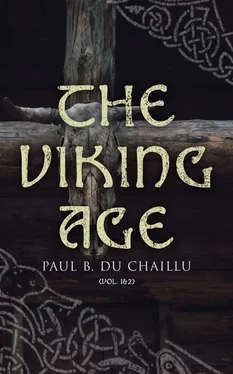The custom of a man giving himself to Odin on a sick bed by marking himself or being marked with the point of a spear, probably arose from the disgrace which was supposed to attach to a man who died unwounded in his bed, and not in battle. Odin himself 271followed this practice, which enabled a man to come to Valhalla. … When tired of life, or of old age, men gave themselves to Odin by throwing themselves from the rocks.
Eirik the victorious, who fought against Styrbjörn, gave himself to Odin in order to get the victory; and Harald Hilditönn was killed by Odin himself, because he had become so old.
The earliest account given of a human sacrifice in the North is that of Domaldi, which, if we may trust the genealogies, took place about the beginning of the Christian era.
“Domaldi inherited and ruled the land after his father Visbur. In his days there was in Sweden great hunger and famine; then the Swedes made large sacrifices at Uppsalir. The first autumn they sacrificed oxen, but the season did not improve; the second autumn they sacrificed men, but the season was the same or worse; the third autumn the Swedes came in crowds to Uppsalir when the sacrifice was to take place. The chiefs held their consultations, and agreed that the hard years were owing to their king, and that they must sacrifice him for good years, and should attack and slay him, and redden the altars with his blood. And thus they did” (Ynglinga Saga, ch. 18).
“Before the holding of the Althing (in the year 1000) in Iceland the heathens held a meeting, and resolved to sacrifice two men from every district of the land (Iceland was divided into four quarters), and to invoke their gods that they should not let Christianity spread over the country. Hjalti and Gizur had another meeting with the Christians, and said they would have human sacrifices as many as the heathens, adding: ‘They sacrifice the worst men and cast them dawn from rocks and cliffs, but we will choose them for their virtues, and call it a victory-gift to our Lord Jesus Christ; we shall live the better, and more warily against sin than before. Gizur and I will give ourselves as a victory-gift on the behalf of our district’ ” (Biskupa Sögur i.).
From the following passage it will be seen that when Christianity gained a footing in Iceland, human sacrifices were abandoned:—
“Thorólf Heljarskegg (Hel-beard) settled in Forsœludal (Iceland); he was a very overbearing man and unpopular, and caused many a quarrel and uproar in the district. He made himself a stronghold (virki) south at Fridmundará, a short way from Vatnsdalsá, in a ravine; a ness was between the ravine and the river, and a large rock in front of it. He was suspected of sacrificing men, and there was not one in the whole valley that was more hated than he” (Vatnsdœla, ch. 16).
Hallstein, an Icelandic chief, son of the Norwegian chief, Thorólf Mostrarskegg,
“Dwelt at Hallsteinsnes. There Hallstein sacrificed his son, in order that Thor might send him high-seat-pillars (126 feet); thereafter a tree came on his land, sixty-three ells in length and two fathoms (6 ells = 12 feet) thick; this was used for his high-seat-pillars, and of it are made the high-seat-pillars of nearly every farm in the Thverfjords” (Landnama ii., c. 23). 272
CHAPTER XXIII.
RELIGION.—IDOLS AND WORSHIP OF MEN AND ANIMALS, ETC.
Table of Contents
The introduction of idol worship—The gods magnificently dressed—Besmearing the gods—Descriptions of the gods in temples—Amulets representing the gods—Worship of men after death—Animal worship—Worship of groves and natural objects—Fire regarded as holy.
It is impossible to tell at what time idols or representations of the gods came to be introduced; it is however certain from the Sagas, that they were already very common in the temple before Christian missionaries came to preach a new religion. At some period, and we know not how the change took place, we see that likenesses were made to represent some of the gods, which were often adorned with fine clothes and ornaments of silver and gold, and as a rule stood on an elevation or pedestal, which also seems to have served as an altar. 273Occasionally they were besmeared with fat, possibly to give them a bright appearance.
There must have been many idols representing different persons who were worshipped besides the Asar, as we find that Thorgerd Hördabrud was also represented.
In the great temple in Mœri, in Norway, all the gods were seated on chairs, and the idol of Thor was magnificently adorned with precious metal. This god was also in the temple belonging to Hakon and Gudbrand in Gudbrandsdal.
“Then they (Fridthjof and Björn) heard that Beli’s sons were in Baldr’s hagi at the disablót ; 274they went up there, and asked Hallvard and Asmund to damage all ships small and large which were near; and so they did. They went to the door in Baldr’s hagi; Fridthjof wanted to go in; Björn told him to be wary, but he wanted to go alone. Fridthjof asked him to stay outside and keep watch. Then Fridthjof went in, and saw that few people were in the disar-hall . The kings were at the disablót and sat drinking; there was fire on the floor, and their wives sat at the fireside and warmed the gods, and some besmeared them with grease and wiped them with a cloth” (Fridthjof’s Saga, 9).
When Sigmund was ready to start for an expedition to avenge his father—
“The Jarl (Hakon) went out with him and asked, ‘What belief hast thou?’ Sigmund answered, ‘I believe in my might and strength.’ The Jarl replied, ‘It must not be so; thou must seek for help where I put all my trust, which is in Thorgerd Hördabrud. Let us go to her, and try to get luck for thee from her.’ Sigmund told him to do as he liked; they went to the woods, and then, by a little by-path, to an open space in the forest where there was a house with a fence around it; this house was very fine, and the carvings were ornamented with gold and silver. Hakon and Sigmund entered with a few men; there were many gods, and so many glass-windows, that there was no shadow anywhere. A splendidly dressed woman was in the inner part of the house opposite the entrance. The Jarl threw himself down, and lay long before her feet; then he rose and told Sigmund that they must make her some sacrifice, and put silver on the stool before her. ‘But as a mark that she will accept, I want her to let loose the ring she wears on her arm; thou, Sigmund, wilt get luck from that ring.’ The Jarl took hold of the ring, but it seemed to Sigmund that she clenched her fist and he did not get it. He threw himself down a second time before her, and Sigmund saw that he wept; he rose, and took hold of the ring, which then was loose, and gave it to Sigmund, who promised not to part with the ring” (Færeyinga Saga, ch. 23).
When Hakon Jarl, after having been baptized in Denmark, had again adopted the practice of the pagan religion,
“He heard of a temple which was the largest in Gautland, while it was heathen. In that temple were one hundred gods. Hakon took all the property which was in it. The men who guarded the temple and the sacrificing-place fled, while some of them were slain; Hakon went back to his ships with the property and burnt and destroyed all that he met with on the way, and had very much property when he came down. While he was making this ravage in Gautland, Ottar Jarl, who ruled over a great part of Gautland, heard of it; he quickly started and gathered all the land host against Hakon Jarl, and attacked him. They at once began the battle; Hakon was overpowered, and at last fled with his men, and went to Norway. Thereafter Ottar Jarl summoned a Thing , and declared at it that Hakon should be called varg-i-veum (wolf in the holy place), because, said he, no man had done worse deeds, for he had destroyed the highest temple in Gautland, and wrought many other evil deeds; that no one knew any example of such things, and that wherever he went he should have that name” (Jómsvikinga Saga, ch. 12).
Читать дальше












